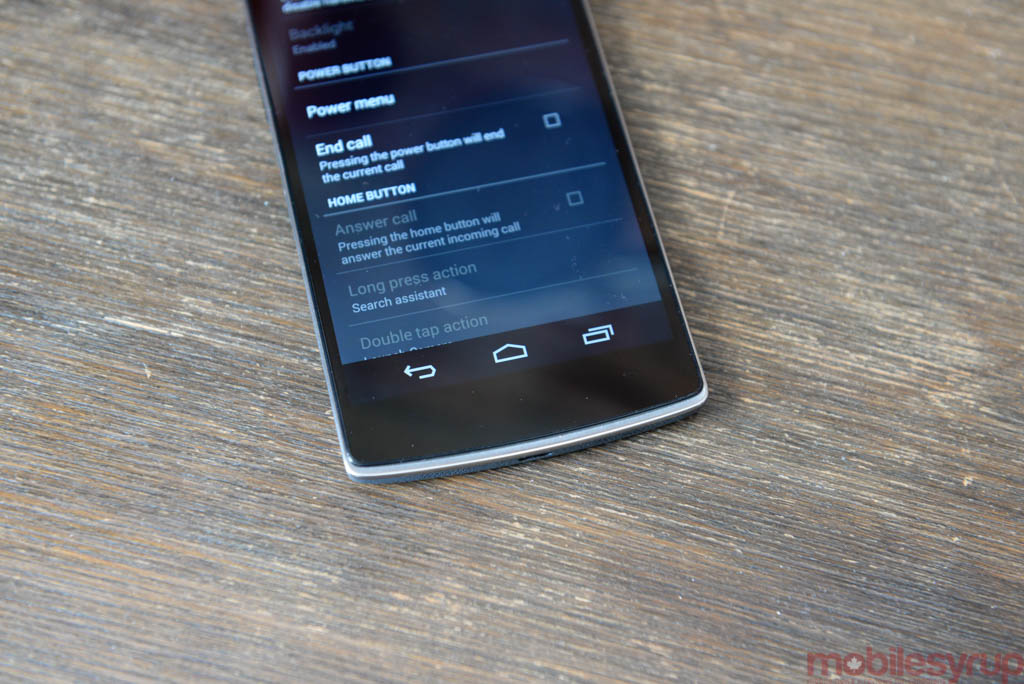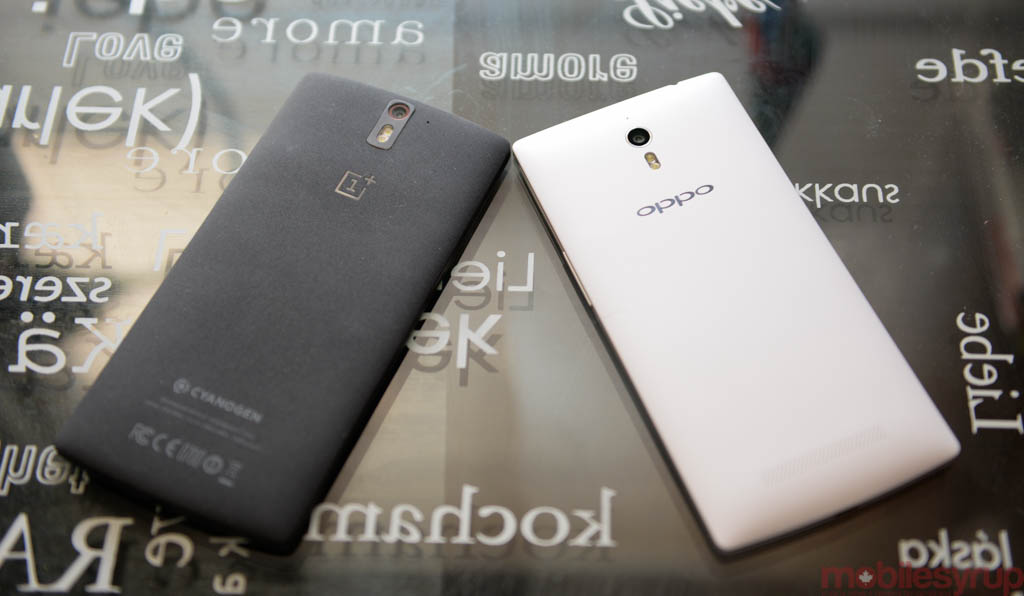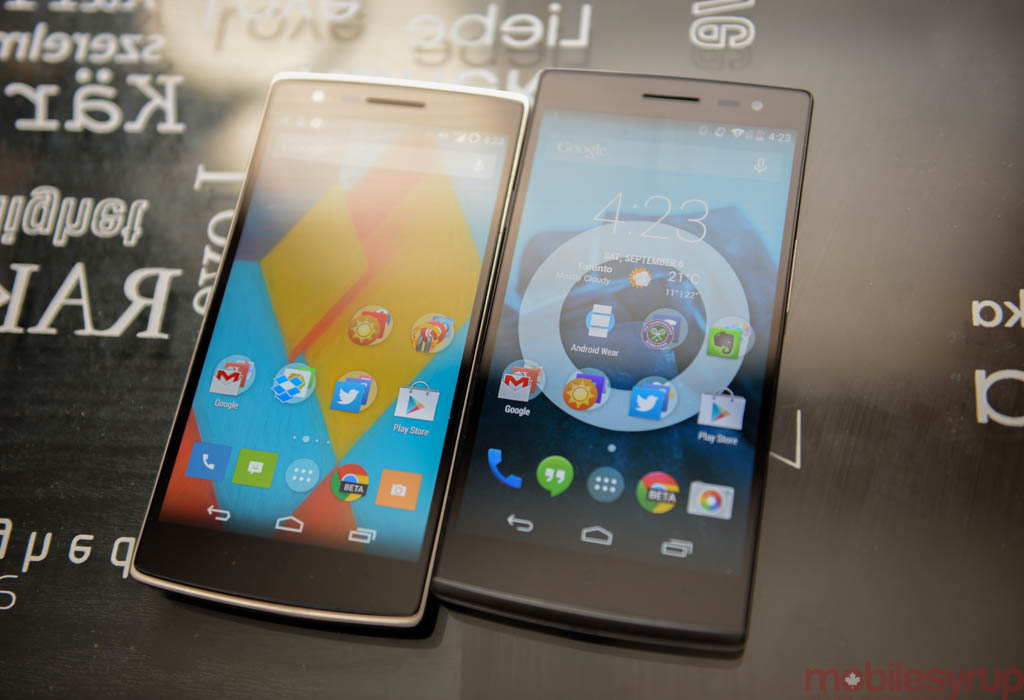
At last count, MobileSyrup has written 16 articles directly about the OnePlus One. Expended thousands of words on a company that, for the first few months, tripped over its own virtual feet more than any other we could recall. We were fascinated by its marketing missteps, entranced by its price and frustrated at its scarcity.
Now, on the eve of another major 5.5-inch device’s release, we take a look at the OnePlus One for what it is: a large, beautiful and high-performance Android smartphone with just enough problems to avoid a wholehearted recommendation. Still interested? Read on with us.
Specs
- Android 4.4.4 based on CyanogenMOD 11S
- 5.5-inch 1920×1080 pixel IPS display
- 2.5Ghz quad-core Qualcomm Snapdragon 801 SoC w/ Adreno 330 GPU
- 3GB RAM
- 13MP rear camera / 4K video capture
- 5MP front camera
- 16/64GB internal storage
- 152.9 x 75.9 x 8.9 mm
- 3,100mAh battery
- HSDPA 850 / 900 / 1700 / 1900 / 2100, LTE 700 / 1700 / 1800 / 2100 / 2300 / 2600
In the beginning…
There is something compellingly simple about the OnePlus One’s lineage: a former employee of Chinese OEM Oppo sets out with a small team to make a flagship device that sells at half the cost of its competitors’ best products, with the intention of penetrating the impossibly saturated North American smartphone market.
Things have not gone smoothly for OnePlus. The company has been piggybacking on Oppo’s already-limited manufacturing facilities, so inventory has been limited, necessitating a restrictive invitation system that garnered attention more for its absurd contests than the substance of its product.
The One’s spec sheet to price ratio was almost too good to be true when it first came to light, and even with newer flagships emerging established brands like Samsung, LG and Apple, OnePlus’s price advantage has not abated.
Considering the device is only sold unlocked and online, it bears more than a passing resemblance to those in the Nexus program. That it is updated directly by CyanogenMOD, a light, powerful skin based on the Android Open Source Project, means that users get the latest version of the software more quickly than most carriers and OEMs could even dream of issuing them.
So, is the OnePlus One any good?
What Works
There are a lot of reasons to like the OnePlus One. It’s fast; it’s got a big, beautiful, high-resolution screen; it’s camera is pretty good; it functions expeditiously on every LTE network in Canada; and it’s cheap.
The reality of the OnePlus One is that, with CyanogenMOD’s software expertise, the company was able to sidestep many of the regional awkwardness that plague Android imports, from unknowns like Oppo and Xiaomi to big players like Samsung and LG.
To experience the OnePlus One is to witness just how far Android as an ecosystem has come in just two years. Such a high-resolution display would have been both battery-eating and cost-prohibitive in 2012; now it is not only of excellent quality, but attainable at a reasonable enough cost to eke a small profit from every panel.
The device itself, while large even compared to other 5.5-inch devices, is well-constructed and solid. It’s chrome-coloured plastic beyond the glass panel, which gently slopes at the top and bottom to reveal a reverse lip of sorts, but the back is a nice textured felt, similar in texture to a nail file (though not as harsh). It’s unique and actually aides in one-handed use. The right-side power button and left-side volume rocker are solid.
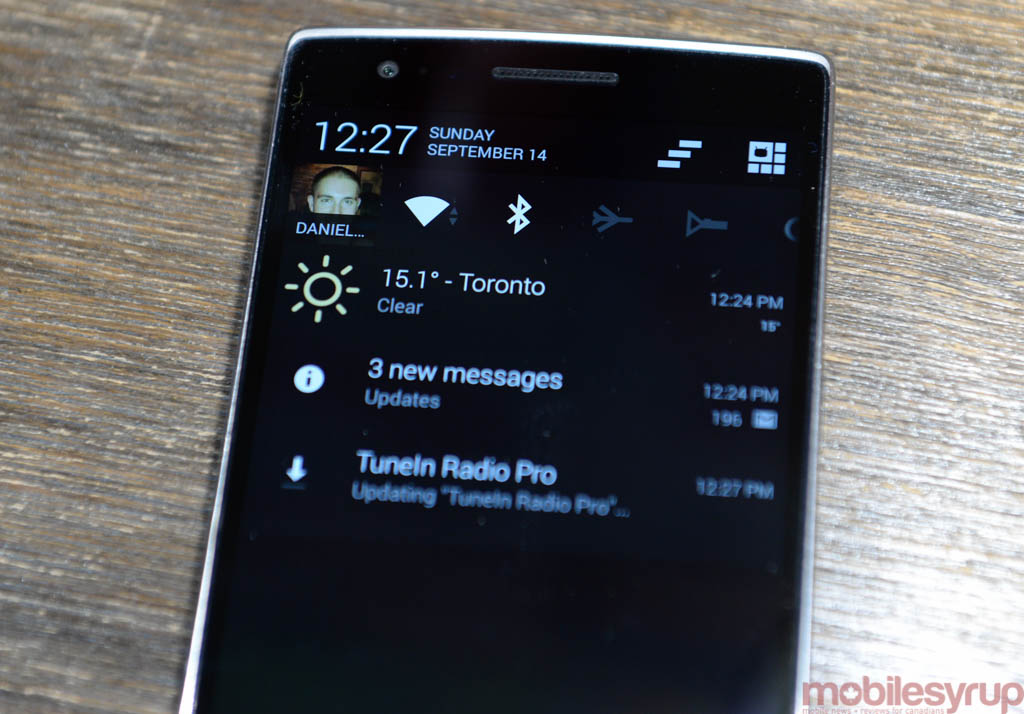
Similarly, the rest of the spec sheet forces users to beg the question, Why did my smartphone cost so much? Of course, companies like Samsung, LG and HTC charge a premium for their flagships by selling them to carriers which in turn use subsidies to incentivize potential customers, but the gist is this: OnePlus is likely not making much money from its first device. What it is doing is building a reputation as a reliable company with a smart business model, and one that, through partner CyanogenMOD, is not forced to spend millions of dollars on R&D to differentiate itself from the competition. It believes — a philosophy it shares with Motorola — that stock Android is both beautiful and functional.
So how goes the OnePlus One get on? In daily tasks, beautifully. The screen is not only responsive, but with wide viewing angles and superlative colour reproduction, easy on the eyes. The Snapdragon 801 processor makes mince meat of the majority of apps and games — it is the same CPU/GPU combo found in the Galaxy S5 and LG G3 — and enjoys an extra GB of RAM over the vast majority of Android flagships today (aside from the Note 3/4 and G3).
But what high-end Android flagship isn’t really fast these days? I mean, you’re not rendering 4K video clips on this thing; you’re watching YouTube videos and insulting my reviews in Chrome.
What the OnePlus One does right is meld all of those disparate pieces of hardware into a functional, cohesive smartphone, one that you pick up and go, Huh, this costs $349? (It doesn’t quite cost that, though: with a ridiculous $28 shipping charge and DHL’s punitive $80 import fees, Canadians are going to pay considerably more for the OnePlus One than the Nexus 5).

Let’s use the camera as an example: OnePlus is one of the few companies to tout the actual camera module inside the housing. It lacks optical image stabilization, but the 13MP sensor and f/2.0 lens have the chops to bring home (and upload to Google+) a surprisingly high-quality spread of photos, even in low light. It’s not going to give your Galaxy S5 a run for its money, but hear this: it’s the second-generation version of the 1/3.06″ sensor found inside the LG G2, LG G3 and second-gen Moto X. In other words, though nominally identical in most ways, it’s still a newer part than the solution found in some of the industry’s best Android devices.
In terms of camera output, the OPO takes a mean daylight photo, with accurate colours and a surprisingly low amount of noise reduction. Chalk this up to CyanogenMOD’s custom camera interface, which relies on a series of vertical swipes to move between modes, and a lack of finished-product meddling, and you have a recipe for neutral, if unremarkable colours.
The OnePlus also knows when to crank the light sensitivity (ISO), though the relatively small sensor doesn’t perform as well as the HTC One M8 or Sony Xperia Z2 in low light. Indeed, grain is the name of the game here in anything but the best conditions since, as I said, noise reduction is minimal, which exposes the embarrassingly small amount of available waves when taking shots in less-than-ideal conditions. Still, being able to achieve a usable photo at ISO 4500 at 1/14 is something most cameras can’t achieve.
HDR manages to smooth out of some of those rough edges, combining exposure of the fore and background of a photo to achieve a more uniform palette, but the software lacks the IQ of a Galaxy S5 or iPhone 5s. The OnePlus, as can be seen below, is capable of some incredible shots, and its macro abilities are up there with the top Android devices on the market.
The device also excels in video capture, perhaps even more so than for still photos. Not only can the device achieve a ridiculously-high bitrate of 57Mbits when shooting 4K video (3840 x 2160 pixels) at 30fps, but it is not limited to five minutes of video like the majority of its competitors. There’s even an ultra-wide 4096 x 2160 pixel option, which captures footage at a cinematic 24fps at megabyte-busting 63Mbits. In other words, the Snapdragon 801 chip is working to its fullest potential here.
CyanogenMOD is not just a take on stock Android, though: the company has, as it has legitimized over the years, managed to create a number of interesting solutions to Google’s biggest mobile problems quite on its own. Theme Manager, for instance, provides an eloquent alternative to having to search for and download various custom launchers, icon packs and wallpapers by bundling them all together in a single place. Sure, most people won’t bother with changing the default colour scheme — it’s fine as it is — but the capability is there.
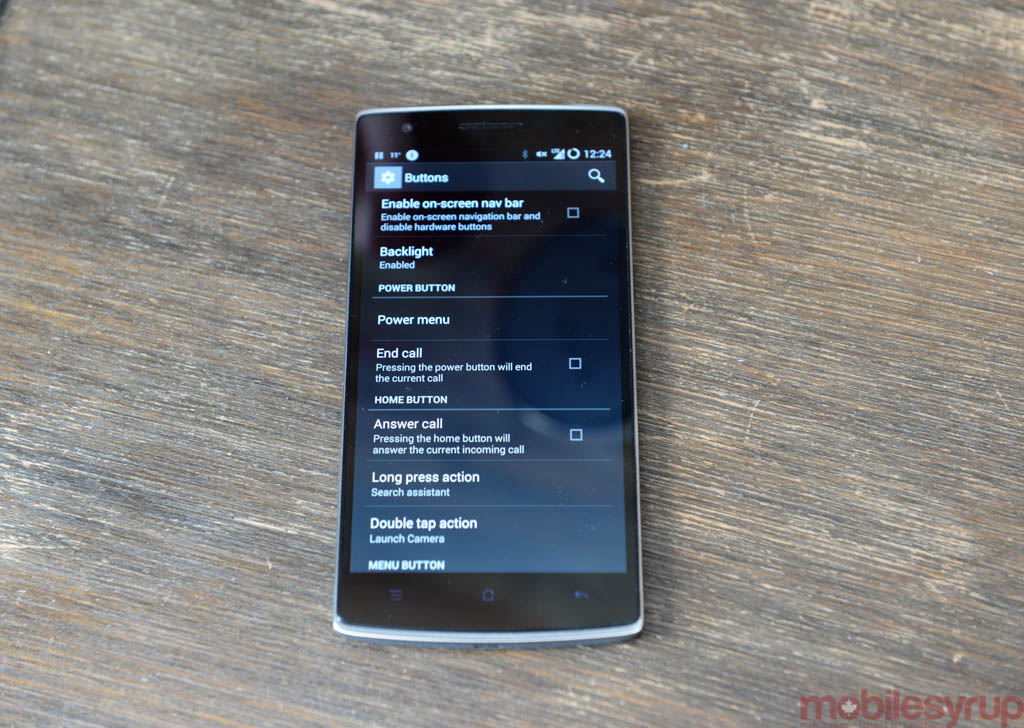
And because the OnePlus One shares a chassis with the Oppo Find 7A, capacitive menu buttons are below the display, making it possible to switch between the two modes on the fly. I prefer the on-screen variety, but if one is looking to eke out as much screen real estate as possible, the choices are there. CyanogenMOD has wisely included the option to create custom launch commands from those buttons, too, so double-tapping on the Home button, for instance, can launch the camera.
Then there’s the added security features, such as per-app permissions and an unique approach to messaging encryption that errs on the side of simplicity. Similar to iMessage, but for CM users, WhisperPush is an end-to-end encryption solution for text-based communications, useful but for the fact that the CyanogenMOD install base is just over one million, peanuts compared to Apple or Samsung.
CM also includes a very capable audio equalizer, which works well with the excellent audio chipset found in the phone. Then there’s the prospect of receiving software updates only marginally slower than the Holy Grail of “Pure Android,” the Nexus, since CyanogenMOD is entirely a software play and doesn’t need to amble through the bureaucratic confines of a large corporation to issue an update (which has its downsides, as we’ll see in the next section).
Battery life, too has been outstanding since we took possession of the OnePlus One. The 3,100mAh battery, coupled with a Qualcomm system-on-a-chip that we’ve found to be extremely efficient across its four Cortex A15-like cores, lasts for between 14 and 18 hours with mixed usage on a charge. That includes a mixture of phone calls, texts, music listening, web browsing, Twitter notifications, and some gaming.
What Needs Work
Here’s where things get tricky: how much do you forgive a high-end device for not being perfect when its price undermines everything we know as a high-end product? In my experience, quite a bit.
Let’s look again at that 1080p display. It’s bright, colourful and expansive. But its black levels are atrocious, revealing more grey than a cold fall afternoon in Edmonton.
Then there’s the touchscreen issue, which appears to be plaguing almost everyone with a OnePlus One in hand. While several fixes have cumulatively addressed the majority of OPO issues since launch, boosting the software to Android 4.4.4 from 4.4.2 in the process, one showstopper remains: a multitouch bug that prevents the display from identifying two taps close together. If you’re not familiar with such an issue, that’s OK: there hasn’t been one quite like this since the Nexus One, which debuted in December 2010.
What’s needed to fix the problem is a driver update from the creator of the OnePlus One digitizer, Synaptics, but it speaks to the lack of coherent Quality Control and Testing apparatus used before launch. Even CyanogenMOD has distanced itself from the problem, claiming it to be a hardware malfunction.
(A custom kernel from developer Francisco Franco has reportedly been released to overcome the screen issues, but installing it involves unlocking the bootloader, rooting the software and flashing the new kernel through a custom recovery, a process many would prefer to avoid.)
Less of an issue, but certainly still relevant, is the lack of wide distribution: it’s hard to get a OnePlus One at the moment, though things may change in October when the invite system gives way to a more traditional pre-order model.
Add to that the lack of a North American customer service infrastructure and you have the potential for some pretty aggravated customers. For example, an early batch of OnePlus Ones had an issue with yellowing of its display panels, forcing users to return their units, turning into a month-long RMA turnaround.
Availability and Competition
The OnePlus One is not widely available in Canada like other high-end smartphones, or like the Nexus 5. In fact, because of its invite-based order system, it’s still quite difficult to buy.
Once purchased, it’s also less inexpensive, due to shipping and duty charges, than it would be for Americans: in total the 64GB version came to just over $480. At the price, it’s no longer the “insanely cheap flagship killer” OnePlus envisions, but still excellent value.
In terms of immediate competition, the device comes closest to the LG G3 in terms of raw specs, with the latter outfitted with a higher-resolution but low-quality IPS panel and the same speeds and feeds. The OnePlus One is in many ways a better phone, with a smoother Android experience, a better camera and more potential storage for less money.
The Samsung Galaxy S5, too, is a better phone in many ways — its camera is superior, as is its screen and form factor — but it’s also more than twice the cost for a version with the same amount of storage.
The Nexus 5, approaching 11 months on the market, is probably the One’s biggest straight competitor, priced at $349 and $399 for the 16 and 32GB versions respectively, but the OnePlus is clearly the winner here.
And the iPhone 6 Plus, a phone that costs more on contract than the OnePlus One does outright, shares roughly the same size and screen resolution. Such a realization speaks not only to the premium certain brands afford, but also to the state of Android as a whole, which through commoditization of parts and competition of brands has eroded profit margins to nothing.
It’s hard to believe OnePlus has a sustainable business selling high-end phones for $350, but here we are, reaping the benefits.
The OnePlus One is available in a 16GB white version for $299 USD, and a 64GB black model for $349 USD.
MobileSyrup may earn a commission from purchases made via our links, which helps fund the journalism we provide free on our website. These links do not influence our editorial content. Support us here.




